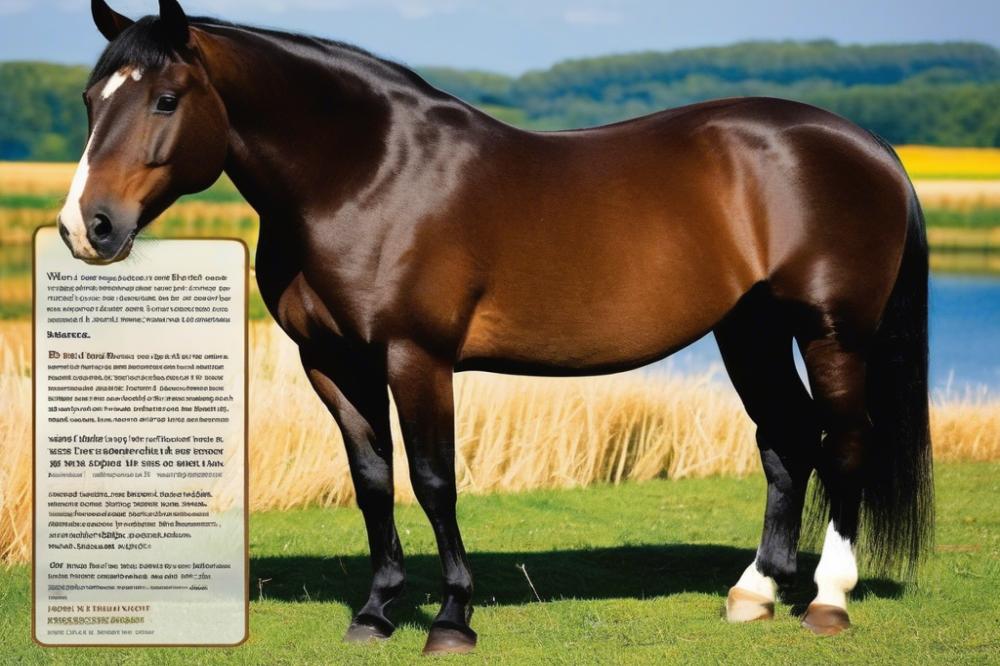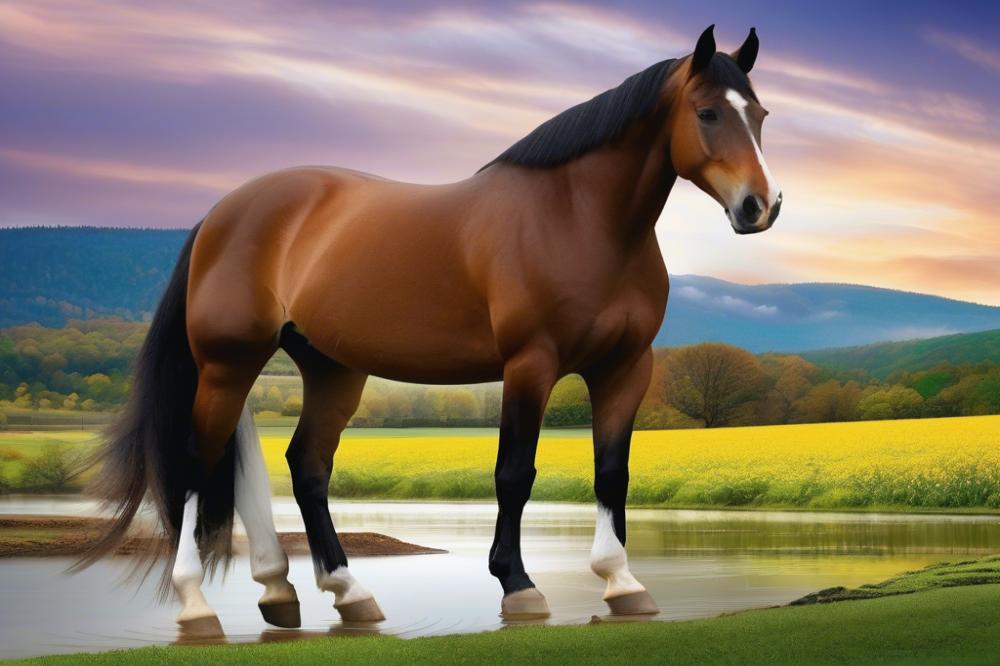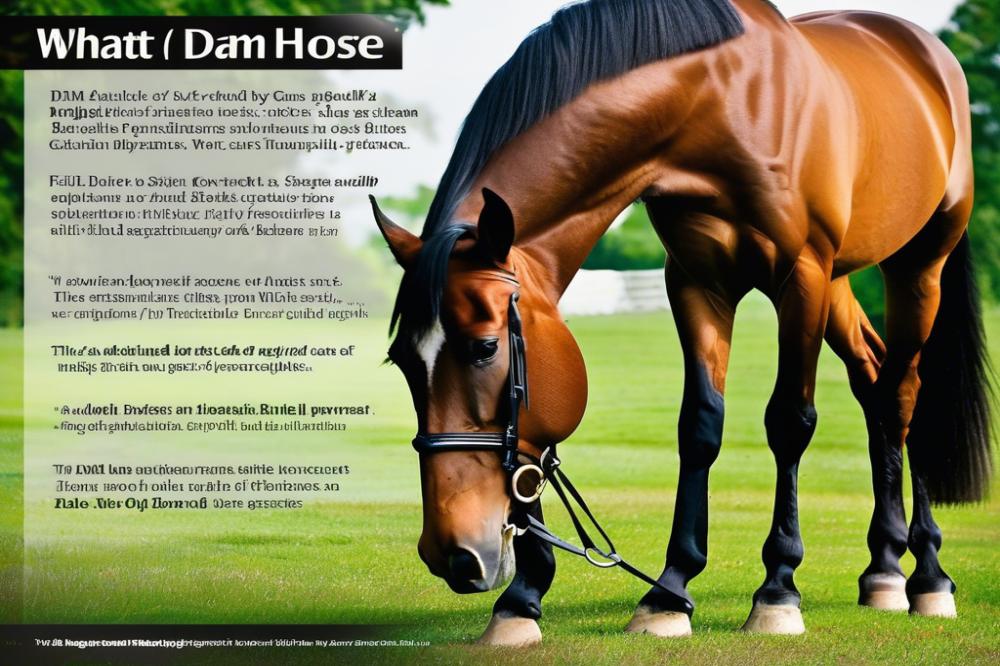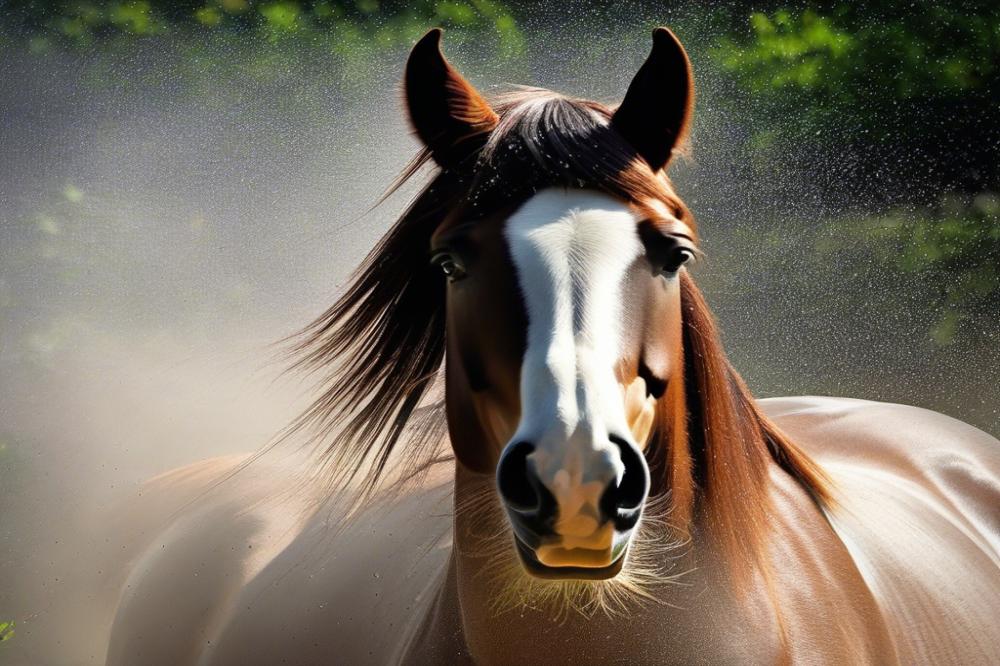What Is a Dam Horse?
When you hear the term “dam horse,” it may sound a bit mysterious, almost like a riddle waiting to be solved. Simply put, a dam is a female horse that has produced offspring. This might be your first encounter with the term in the sprawling world of horse breeding, where understanding lineage is as essential as knowing your saddle from your stirrup. It’s fascinating how these majestic creatures carry on their traits through generations!
Horse breeding can be a tapestry woven with care, patience, and a sprinkle of expertise. The dam plays a pivotal role in this picture. Not only does she give birth to foals, but she also passes down crucial genetic traits. Have you ever pondered on how some horses are agile like a deer or have coats that shine like polished wood? You can thank the dam and her part in equine reproduction for those remarkable characteristics. Recognizing the importance of a dam horse helps enthusiasts appreciate the complexity of horse genealogy and what it means for each horse’s future.
This article serves to peel back the layers on the fascinating world of dam horses and their significance in horse care and breeding practices. As we navigate through various horse terms and delve deep into the intricacies of the breeding process, we aim to provide you with valuable insights. So, saddle up as we embark on this exciting journey! Along the way, we’ll even touch on topics like selenium deficiency in horses symptoms and the intriguing world of buckskin horse breeds. You won’t want to miss it!
Understanding Equine Terminology

Let’s dive into some basic horse terms. In the world of equine terminology, you often hear the words “dam,” “sire,” and “offspring.” Each one plays a specific role in horse breeding. So, what does it all mean?
The term dam refers to the mother horse. She is responsible for carrying and nurturing the foal before it is born. On the flip side, the sire is the father horse. He contributes half of the genetic material to the foal. The offspring, obviously, are the young horses produced by the dam and sire. They inherit traits from both parents.
Many people mix up the terms “dam” and “sire.” The main difference lies in their parental roles. While the dam gives birth, the sire typically has a role during the mating process. It’s like teamwork in a family. Without the dam, there would be no foal to carry on the family line. Each parent offers something special to horse genealogy.
The role of the dam in equine reproduction is vital. She provides not only her genetics but also a nurturing environment for the growing foal. From the food she eats to the care she gives, everything influences the young horse’s health. A good dam can lead to strong, healthy offspring.
When people talk about horse care, they often overlook the dam’s importance. She not only feeds the foal but also teaches it vital skills. Her instincts guide the foal in learning how to interact with the world. Imagine a mother teaching her child; the same goes for the dam and her young.
Understanding these terms can help anyone interested in horses grasp the basics of breeding and genetics. It may seem overwhelming at first, but breaking it down helps. So, the next time someone mentions a dam horse, you’ll know it refers to the mother in the breeding equation. Just like that, knowledge grows!
The Role of Dam Horses in Breeding

In the world of horse breeding, the dam’s lineage is a big deal. Think of it like tracing your family tree. Just as parents can give their children certain traits, so can a mare pass on characteristics to her foals. This is why equine terminology often highlights the importance of a dam’s background.
One important role of a mare is her ability to influence her offspring’s traits. Coat color, temperament, and even athletic ability can be inherited from her. If a mare has a great competition record, chances are her foals might follow in her hoofprints! Each horse is a blend of genetics, and horse genealogy plays a crucial role in that mix.
There are notable dam horses that have made significant impacts in the industry. For instance, the famous mare, *Best in Show*, was known for producing several champion offspring. Many people in horse care understand how critical it is to consider a dam’s performance history when breeding. It’s like choosing a football team—everyone wants the star players on their side!
When breeders select a stallion for a mare, they don’t only look at the stallion’s lineage. They also think about how the dam’s traits will mesh with those of the sire. That’s where equine reproduction gets really interesting. It’s a fascinating dance of genetics, and every couple has its own rhythm!
Breeders often dive into the statistics and records when evaluating a mare’s potential. The way a dam has produced in her past can offer clues about what to expect in the next generation. Imagine going to a school and checking students’ grades. You’ll want to see if the family’s smart, right? The same goes for horses!
Just like in human families, some horses carry a certain flair that stands out in the arena or on the racetrack. The uniqueness of each mare can make her a prized asset in breeding programs. For those familiar with horse terms, having a strong dam in your bloodlines might just give your horses that extra edge over the competition.
Evaluating a Dam Horse

Key Traits to Assess in a Dam Horse
Evaluating a dam horse requires a careful eye for detail. You want to start with temperament. A calm and friendly demeanor often produces foals that are easy to train. If a horse is skittish or aggressive, those traits may carry over to the next generation. Look for a mare that enjoys human interaction and is cooperative during handling.
Physical traits play a crucial role, too. Good bone structure and muscular build can hint at vitality and strength. A well-proportioned body often leads to better performance and health in foals. Watch carefully for any signs of health issues. A horse with chronic problems may not be the best choice for breeding. Good health can make a world of difference in the offspring.
Pedigree Analysis
Studying a horse’s lineage can give insight into its future potential. This part of horse genealogy is like reading a family tree. You want to know who their parents and grandparents are. If those horses excelled in competitions or breeding, it might be a good sign. Look for champions in the bloodline. Strong genetics can set the stage for success.
Keep an eye out for any negative traits that appear in the family. If the mare’s relatives had health issues or bad temperaments, it might be worth reconsidering. A deep dive into this equine terminology offers clues that can’t be ignored.
Influence of Conformation and Health on Breeding
Conformation refers to how a horse is built. You want all legs standing like they belong to a picture-perfect model. The shape of the body can impact its performance later on. Well-structured horses often have better movement, which is vital for any sport.
Health is another key factor. A breeding mare should be in peak condition. Regular vet checks can reveal hidden issues. If the horse has any ailment, address it quickly. Remember, healthy horses tend to pass on those positive characteristics to their offspring.
When evaluating, think about horse care practices. Proper diet, exercise, and routine care make a significant difference. A well-cared-for horse feels better and performs better. This directly impacts the breeding process. Prioritize the overall well-being of the mare to increase the chances of producing a strong foal.
Breeding Strategies Involving Dam Horses
Methods of Selecting a Dam for Breeding
Choosing the right dam is like picking a star for a movie. It plays a huge role in shaping the cast of future foals. Breeders often look for quality traits that are important in equine terminology. Some things to consider are health, temperament, and performance history. Taking time to study a horse’s lineage can reveal a lot. Breeders pay attention to horse genealogy to identify which bloodlines are strong and which ones may have weaknesses.
It’s not just about selecting a pretty face. A dam with excellent conformation will likely pass on desirable traits to her offspring. Also, one should consider how the horse has performed over time. Sure, it might be tempting to choose the flashiest dam in the barn. However, it’s vital to look deeper. The goal is to produce horses who excel in competition or pleasure riding. Balance beauty with functionality in your choices.
Considerations for Mating Choices
Once the right dam is selected, the next step involves choosing the stallion. This part can feel like matchmaking for equine romances. Consider the stallion’s attributes as they can greatly complement the dam’s qualities. It’s not just about the size or color; temperament matters just as much. Mixing bloodlines can yield exciting results, but it requires careful thought.
Breeders often ask themselves which characteristics they want in the foal. Do they want speed, agility, or maybe a calmer disposition? Think of it as being a chef. You wouldn’t randomly toss ingredients into a pot. You’d create a recipe based on what flavors work well together. Each horse term has its place in the grand scheme of breeding decisions.
Importance of Genetic Diversity
Genetic diversity is essential in horse breeding. A diverse gene pool helps strengthen the entire population. Without it, the risk of inherited health problems increases. Inbreeding can make horses more susceptible to diseases. A little variety can spice things up, much like a well-seasoned dish. Mixing different bloodlines can lead to foals with robust health and outstanding abilities.
Breeders must think long-term. They want the next generation to be strong and capable. Horses with better genetic variation are often more resilient. When you explore different bloodlines, you open up a world of possibilities. There’s a sense of adventure in breeding, akin to exploring uncharted territories. Decisions made today can affect future generations. Focusing on maintaining genetic diversity is a responsible step toward healthier horses.
Challenges and Considerations
Common Issues Faced by Dam Horses
Breeding horses comes with its share of trials. One major challenge is the health of the dam. Sometimes, they may face difficulties during pregnancy or after giving birth. This can affect their well-being and the health of the foal. Keeping an eye on nutrition is essential. A balanced diet can go a long way in preventing problems.
Another common issue includes breeding complications. Even the best-laid plans can go awry. In some cases, the mare may not conceive as expected. This can lead to frustration for breeders. Understanding horse terms can help folks navigate these situations. Using the right equine terminology can also make conversations about breeding clearer.
Health and Reproductive Concerns
Health concerns can be a real headache. Mare owners should regularly check for any signs of illness. Issues like infections can arise during the breeding season. It is important to catch these early. Regular vet check-ups are not just a good idea, they are vital.
When it comes to reproduction, age is something to consider. Older mares may have a tougher time in terms of fertility. Keeping detailed horse genealogy records can help breeders make informed decisions. This historical data offers insights into potential reproductive issues that may pop up down the road.
Management Practices for Optimal Breeding Outcomes
Management practices play a key role in breeding success. Creating a comfortable environment for the mare is a step in the right direction. A stress-free atmosphere can greatly affect her reproductive health. Limiting disturbances and providing good space can help. It’s like giving her a cozy nest before her big moment.
Proper horse care shouldn’t be overlooked either. Grooming, regular exercise, and access to clean water boost health. Formulating a solid breeding plan is also essential. Knowing the right timing for breeding is crucial to avoid disappointment. The window of opportunity can be narrow, much like a racetrack finish line.
Focusing on these aspects can yield optimal results. There’s no magic formula, but diligent care coupled with effective management goes a long way. Just remember: patience is more than a virtue in horse breeding; it’s a necessity!
The Future of Dam Horses
Trends in Breeding Practices
Breeding practices are always changing. People involved in horse breeding are now focusing on traits that enhance performance and temperament. The idea is to produce animals that excel on the race track, but also have calm minds for riding. The days of haphazard breeding are disappearing. Instead, many breeders study horse genealogy to choose the best pairings. This careful selection helps to improve the overall quality of the horses.
Breeders are also more informed today. They attend workshops and seminars, diving deep into equine terminology. The goal is to become experts in understanding what makes a great horse. People have begun to appreciate not just speed but stamina and health. It’s like looking for the whole package, rather than just a flashy exterior.
Role of Technology in Equine Genetics
Technology has revolutionized the world of horse care and breeding. DNA testing is now common. This helps breeders know the strengths and weaknesses of their horses. With a simple test, breeders can identify genetic traits that might come from generations past. Isn’t that nifty? It’s almost like having a treasure map that leads to the best characteristics in a horse lineage.
Tools like ultrasound and artificial insemination make equine reproduction easier and more precise. Breeders can carefully plan each mating to produce the best foals. This way, they can save time and resources. The science behind horse breeding has never been more precise.
The Importance of Preserving Bloodlines
Bloodlines are essential, much like a family tree. They tell the story of a horse’s heritage and potential. Keeping track of these lines is vital for future generations. This is where horse terms come into play. Knowing the terms helps breeders discuss lineage accurately, avoiding any mix-ups.
Preserving bloodlines protects against genetic disorders as well. Imagine you have a family full of musicians. If you keep the best traits, you might raise the next big star! Breeders work hard to maintain quality. They avoid having too many horses with the same traits to prevent weaknesses.
In short, a bright future for horses lies in the careful marrying of science and tradition. There’s a lot of excitement ahead, and who knows? The next champion could be just around the corner. With informed choices and a sprinkle of modern technology, the world of horse breeding is set to gallop forward.
Final Thoughts on Feeling a Connection
Reflecting on the significance of dam horses, it becomes clear they are much more than just a part of breeding. These animals represent a lineage, a story that stretches back through generations. Their influence plays a crucial role in shaping the future of many equestrian sports. A well-bred horse can excel in various disciplines, from jumping to dressage levels, showcasing the potential that careful breeding can unlock.
When it comes to the equine industry, dam horses are like the cornerstone of a sturdy building. They provide the essential attributes that contribute to a horse’s performance, temperament, and durability. So, in a way, every rider and trainer out there is linked to this lineage, forming a tapestry woven from the past. Most importantly, they remind us that behind every great horse, there is often a remarkable dam that paved the way.
As we wrap up this discussion, it’s worth chuckling at the thought of how horse ages are often compared to human years. Picture it: a horse that’s just a few years old can already seem wise beyond its years, almost like taking advice from your quirky grandparent! This quirky connection truly highlights the bond we develop with these magnificent creatures.
In every hoof beat and every training session, the legacy of dam horses impacts our riding journeys. Whether you are a casual rider or aiming for the top of the competitive world, these remarkable animals play an essential part. They help shape not just the horses we ride but also the spirit of the entire equestrian community. So, the next time you saddle up, take a moment to appreciate the lineage behind the horse you’re with. It’s a heartfelt reminder that every horse carries the weight of its ancestry, and that story is a beautiful one to be part of.



